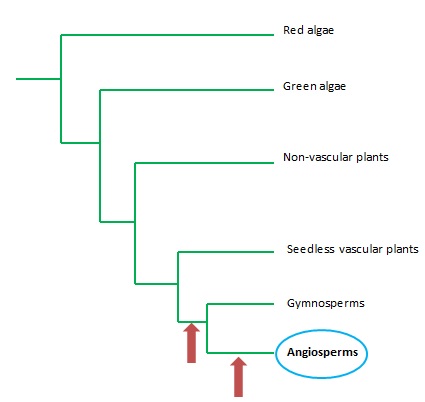Classification
Domain: Eukarya
Kingdom: Plantae
Phylum: Magnoliophyta
Class: Magnoliopsida
Order: Caryophyllales
Family: Caryophyllaceae
Genus: Silene
Species: Silene latifolia
The above phylogeny tree is a representation of where Silene latifolia fits in regards to other plants based on morphological information. S. latifolia is classified in the phylum Magnoliophyta which is the same as Angiosperms. The first red arrow points to a synapomorphy that separate gymnosperms and angiosperms from the rest of the other plants. Both of these have vascular tissues, pollen, and seeds. The second red arrow points to a synapomorphy that makes Angiosperms unique from Gymnosperms. Angiosperms are unique because they produce flowers and fruits.
Domain: The domain Eukarya classifies organisms by cells having a true nucleus, membrane-bound organelles and DNA as genetic material (Campbell, et. al., 2008). This domain is very diverse and includes, plants, animals, and fungus. Check out the morel mushroom to learn about another organism in this domain.
Kingdom: Organisms in the kingdom Plantae are classified by the ability to produce food by photosynthesis. These organisms use carbon dioxide, sunlight, and water to make sugar and have cell walls made of cellulose to provide support for the plant. The kingdom Plantae is very diverse, check out wild rice to learn about a different plant species.
Phylum: Members in phylum Magnoliophyta are more commonly known as Angiosperms. Defining characteristics of this phylum are plants that have flowers and seeds that develop within the flower's ovary. Another plant found in this phylum is the kiwi fruit.
Class: Members of the class Magnoliopsida are known as dicotyledons. These organisms have net-like veined leaves, 5 petals in the flowers, and 2 cotyledons (Campbell, et al., 2008).
Order: Organisms in the order Caryophyllales are nonwoody, herbaceous plants that have leaves on opposite sides of the stem.
Family: The Caryophyllaceae family consists of herbaceous plants that include biennials, perennials, and annuals. It also includes weeds (Filatov, 2005; Gibson et. al., 2013).
Genus: The Silene genus contains
hermaphroditic and female individuals. It has also evolved to
separate male and female sexes. Because Silene latifolia has
male and female flowers on separate plants, it is classified in
this genus (Gibson et. al., 2013).

The phylogenetic tree above is based on morphological data. As
stated previously, the order of Silene latifolia is
Caryophallales. This purple boxes of this tree helps to depict
where Caryophyllales fits within the Plantae kingdom. Common
characteristics that all members of the order Caryophyllales
share include: succulent stems or leaves, stems generally have
concentric rings of xylem and phloem or vascular bundles, and
multiple pollen morphologies (Soltis et al., 2006). To learn
about a Caryophyllale other than Silene latifolia,
check out
Opuntia chlorotica, the Prickly Pear Cactus.
Check out the Tree of Life web project for more information about Silene latifolia and other organisms as well!